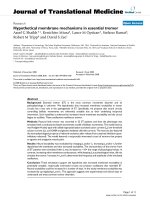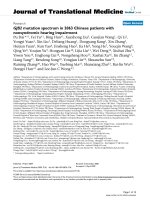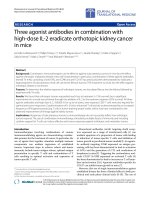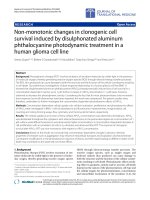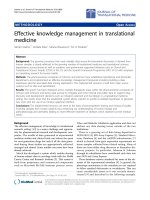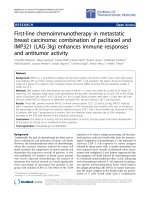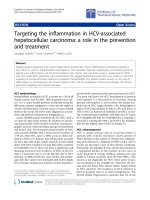báo cáo hóa học:" Protecting HIV information in countries scaling up HIV services: a baseline study" potx
Bạn đang xem bản rút gọn của tài liệu. Xem và tải ngay bản đầy đủ của tài liệu tại đây (246.2 KB, 8 trang )
RESEARCH Open Access
Protecting HIV information in countries scaling up
HIV services: a baseline study
Eduard J Beck
1*
, Sundhiya Mandalia
2
, Guy Harling
1
, Xenophon M Santas
3
, Debra Mosure
3
, Paul R Delay
1
Abstract
Background: Individual-level data are needed to optimize clinical care and monitor and evaluate HIV services.
Confidentiality and security of such data must be safeguarded to avoid stigmatization and discrimination of people
living with HIV. We set out to assess the extent that countries scaling up HIV services have developed and
implemented guidelines to protect the confidentiality and security of HIV information.
Methods: Questionnaires were sent to UNAIDS field staff in 98 middle- and lower-income countries, some
reportedly with guidelines (G-countries) and others intending to develop them (NG-countries). Responses were
scored, aggregated and weighted to produce standard scores for six categories: information governance, country
policies, data collection, data storage, data transfer and data access. Responses were analyzed using regression
analyses for associations with national HIV prevalence, gross national income per capita, OECD income, receiving
US PEPFAR funding, and being a G- or NG-country. Differences between G- and NG-countries were investigated
using non-parametric methods.
Results: Higher information governance scores were observed for G-countries compared with NG-countries; no
differences were observed between country policies or data collection categories. However, for data storage, data
transfer and data access, G-countries had lower scores compared with NG-countries. No significant associations
were observed between country score and HIV prevalence, per capita gross national income, OECD economic
category, and whether countries had received PEPFAR funding.
Conclusions: Few countries, including G-countries, had developed comprehensive guidelines on protecting the
confidentiality and security of HIV information. Countries must develop their own guidelines, using established
frameworks to guide their efforts, and may require assistance in adapting, adopting and implementing them.
Background
Many middle- and lower-income countries are scaling
up HIV prevention, treatment, care and support services
within the context of Unive rsal Access [1] and achieving
the Millennium Development Goals [2]. This involves
collecting individual-level data, which enable individuals
to be tracked over time within and between sites for
clinical management, and can also provide information
for monitoring or evaluating services. Paper-based and
electronic information systems, increasingl y developed
and used in these countries, must ensure the confidenti-
ality and security of these data, yet allow relatively easy
access to such data for both service provision and moni-
toring and evaluation.
Confidentiality and security must be ensured f or data
collection, storage, use and dissemination within coun-
tries and at international levels. This includes the physi-
cal protection of data to guard against environmental
threats, such as floods, fire or other envir onmental
threats, and the protection needed to guard against
inappropriate use by humans of sensitive information,
whether due to inadvertent or deliberate activities.
To improve health outcomes and reduce harm, indivi-
dual health data must be used to inform healthcare.
This involves an ongoing process of refining the balance
between:
a) Maximizing benefits that can and should come
from the wise and fullest use of data
* Correspondence:
1
Programme Branch, UNAIDS, Geneva, Switzerland
Full list of author information is available at the end of the article
Beck et al. Journal of the International AIDS Society 2011, 14:6
/>© 2011 Beck et al; licensee BioMed Central Ltd. This is an Open Access article distribu ted under the terms of the Creative Commons
Attribution License ( which permits unrestricted use, distribution, and reproduction in
any medium, provided the original work is properly cited.
b) Minimizing the harm that can result from either
malicious or inadvertent inappropriate release of
individually identifiable data.
These potential benefits and harms may ac crue to
individuals, groups or inst itutions. While longitudinal
paper-based or electronic patient health data reposi-
tories can provide the basic information to monitor and
evaluate service provision, they also provide opportu-
nities for breaches in confidentialit y of individual
records in consolidated and centrally accessible data.
These considerations motivated the development of a
set of principles or guidelines, which, independent of
context, may help maintain the balance between maxi-
mizing benefit and minimizing harm. To assist countries
in addressing this critical issue, a consensus workshop
was held in Geneva, Switzerland, in May 2006, attended
by national and international experts, which resulted in
the development and publication of the Joint United
Nations Programme on HIV/AIDS (UNAIDS) and the
US President’s Emergency Plan for AIDS Relief (PEP-
FAR) Interim Guidelines on Protecting the Confidential-
ity and Security of HIV Information [3].
The issues described and the solutions proposed by
the Interim Guidelines go well beyond HIV-information
systems [4], and they were developed with the intention
that the guidelines would also be relevant for health sec-
tor-wide information systems [5].
The Interim Guidelines focus on the three interrelated
concepts of privacy, confidentiality and security, all of
which affect the protection of sensitive data. Privacy is
both a legal and an ethical concept. The legal concept
refers to the legal protection that has been accorded to
an individual, based on huma n rights principles [3], to
control both access to and use of personal information;
it provides the overall framework within which both
confidentiality and security are imp lemented . Confiden-
tiality relates to the right of individuals to have their
data protected during collection, storage, transfer and
use in order to prevent unauthorized disclosure of that
information to third parties. Security refers to a collec-
tion of technical approaches that address issues covering
physical, electronic and procedural aspects of protecting
information collected as part of the scale up of HIV ser-
vices. Security must support protection of data from
both inadvertent and malicious inappropriate disclosure,
and minimize data outages due to system failure and
user errors.
The focus of this study was, therefore, to assess how
middle- and lower-income countries have so f ar dealt
with securing the confidentiality of HIV information
through the development of privacy laws, which cover
the different types of data collected through their HIV
clinical care monitoring and eva luation systems, and the
speci fic security measures identified within the data col-
lection, storage, transfer and analysis process.
Methods
In Sep tember 2007, questionnaires were sent out to field
staff pres ent in all 80 countries with UNA IDS offices, which
covered 98 middle- and lower-income countries as some of
the offices covered more than one country. UNAIDS staff,
in conjunction with relevant country staff employed
through PEPFAR, were asked to identify t he mo st appropri-
ate country professional(s) to complete the questionnaire.
Respondents were contacted by the UNAIDS staff, and
UNAIDS or PEPFAR staff were asked to facilitate comple-
tion of the questionnaire by country professionals. Ques-
tionnaires were returned to the respective UNAIDS c ountry
staff member, who revi ewed t he re sponses and followed up
when necessary with the country respondent.
Subsequently, the completed questionnaires were
forwarded to the UNAIDS Secretariat in G eneva. In
Geneva, questionnaires were reviewed and if queries
arose, country staff was again contacted to try to obt ain
answers to the queries. Questionnaires were initially
piloted in four countries, subsequent ly revised, and Eng-
lish, French, Russian, Spanish and Portuguese language
ver sions produced. The data collection perio d was from
September 2007 to April 2008.
A substantial number of country respondents indi-
cated that their countries had already developed such
guidelines, while the majority acknowledged that such
guidelines did not yet exist in their countries. For this
reason, two questionnaires were developed at the
request of the country respondents themselves: one for
countries that reportedly had developed relevant guide-
lines (G-countries); and another one for countries that
had not yet developed such guidelines but intended
to do so (NG-countries). Whet her a G-country or
NG-country questionnaire was to be completed was
agreed after discussions between the country respondent
and their UNAIDS liaison officer. The two question-
naires covered similar topics, with questions for
G-countries phrased in terms of “have you included ”,
whereas questions for NG-countries were phrased in
terms of “would you include ”.
Each questionnaire covered the following three areas:
1. The existence of privacy laws in the country
2. The extent to which countries have been able to
develop and implement a national HIV monitoring
and evaluation system as part of the Three Ones
principles that promote better coordination of
national responses to their HIV epidemic [6]
3. The physical and electronic protection of data, the
conditions of the use of data and release of analyses
based on these data.
Beck et al. Journal of the International AIDS Society 2011, 14:6
/>Page 2 of 8
These areas covered the various measures highlighted
in the Interim Guidelines that countries can take to
scale up services while improving the confidentiality and
security of HIV information.
Some of the analyses produced compared responses
between G- and NG-countries. The responses from
NG-countries can be interpreted as those topics that
respondents w ould “ ideal ly” like to see included in
future guidelines and can be characterized as a “vision
statement”. The responses from G-countries, meanwhile,
provided some “ reality check” in terms of what policies
countries had actually developed and implemented. The
null-hypothesis tested in this study wa s that there were
no significant differen ces in terms of the guidelines that
G-countries had developed and those that NG-countries
indicated that they would include in the future.
Questions were aggregated into six related categories,
each of which dealt with an important measure for
securing the confidentiality of HIV information: infor-
mation governance, country policies, data collection,
data storage , data transfer and data access. The scoring
system assigned “1” to a positive response, while nega-
tive or missing responses received a score of “0”. Scores
were summed and then standardized so that scores for
each category ranged from 0 to 100, where a score of
100 indicated positive responses to all items. Standardi-
zation allowed the individual category scores to be com-
pared across respondents.
Standardized composite country scores are presented
as median and interquartile (IQR) ranges. Associations
between country scores and country HIV prevalence [7],
gross national income (GNI) per capita [8], Organization
for Economic Cooperation and Development (OECD)
income classification [9] and funding received from
PEPFAR were investigated.
Comparisons were analysed using non-para metric
tests, including the Chi-square test with Yates’ correc-
tion, Mann-Whitney U and Kruskal-Wallis tests. Stan-
dardized composite scores were analysed using
univariate or multivariable regression analyses; all ana-
lyses were performed using ei ther OpenEpi [10] or SAS
Version 9.1.2 [11]. All p-values presented are two-tailed.
Results
Seventy-seven completed country questionnaires were
returned, 21 from G-countries and 56 from NG-countries,
aresponserateof80%.Ofthe77respondingcountries,
45% were OECD low-income countries, 39% low-middle-
income countries and 15% upper-middle-income countries.
All countries reported that they had developed a
national strategic HIV plan; all G-countries and 54
(95%) NG-countries reported that they had established a
national AIDS coordinating authority. Eighteen (86%)
G-countries and 44 (77%) NG-countries reported that
they had established a national HIV monitoring and eva-
luation (M&E) system. In terms of the type of data col-
lected through these M&E systems, of the 63 countries
that completed this question, all reported that they col-
lected health sector data, 91% collected data on social
services, 88% collected geographical information, 86%
educational information, 64% economic data and 61%
labour data. No significant differences were observed
between responses from G- and NG-countries.
Aggregated analyses
When comparing G- and NG-countries in terms of the
aggregate categories, statistica lly signific ant higher
scores were observed for G-countries compared with
NG-countries for information governance (p < 0.01)
(Table 1). Conversely, for country policies, data collec-
tion, storage, access and transfer categories, NG-coun-
tries scores were statist ically significantly higher
compared with G-countries (Table 1).
No statistically significant associations were observed
between country score and HIV prevalence or per capita
GNI (Table 2). Similarly, no statistically significant dif-
ferences were observed in terms of countries scores for
the various OECD countries (Table 3), nor between
countries that had received PEPFAR funding and those
that did not (Table 4).
Existing country guidelines
G-countries were asked to provide copies of their rele-
vant policy documents: 13 (62% ) countries did so. How-
ever, none of these documents provided the degree of
detailed guidance described in the Interim Guidelines
[3]. Most of the existing guidelines required the strict
maintenance of medical confidentiality surrounding
HIV-related information, indicating that consent was
frequently required for testing and sometimes for shar-
ing HIV information with other professionals or
individuals.
Confidentiality exemptions were most commonly made
for the purposes of statutory monitoring and reporting,
medical referrals and to inform sexual partners. Of the
57 NG-countries, 33 ( 59%) indicated that they intended
to develop their own guidelines, and 10 (29%) reported
that they had already started this process.
Privacy laws
Eighteen (90%) G-countriesindicatedthattheyhad
existing privacy laws, compared with 31 (57%)
NG-countries [p < 0.02]. Concerning the requirement to
obtain consent for collecting individual data for routine
government analyses, 17 (81%) G-countries indicated
that such consent was required compared with 30 (54%)
NG-countries [p = 0.05]. When asked about collecting
data for research purposes, 19 (91%) G-countries and 45
Beck et al. Journal of the International AIDS Society 2011, 14:6
/>Page 3 of 8
(82%) NG-countries indicated that individual consent
was required for the collection of research data, a differ-
ence that was not statistically significant.
Selected confidentiality and security issues
Guidelines on data collection, storage, ac cess, transfer,
analysis, use an d feedback, which G-countrie s had
included in their policy documents, were similar to
those that the NG-countries mentioned that they would
include. However, 12 (75%) G-countries reported that
data backup and data recovery were covered in their
guidelines, while 51 (98%) NG-countries indicated that
they would include such topics [p < 0.02]. For data dis-
posal, 11 (65%) G-countries had this covered in their
guidelines compared wit h 49 (96%) NG-countries [p <
0.005] that indicated that they would include this topic.
Seventeen (89%) G-countries and 52 (100%)
NG-countries reported that confidentiality needed to
be maintained when collecting individual information
in a clinical setting. Three G-countries and eight
NG-countries reported that this could be done in a
secluded area of an open room, while 1 3 (68%) G-cou ntries
reported that this should be done in a closed room
compared with 49 (93%) NG-countries [p < 0.05].
Ten (56%) G-countries and 50 (96%) NG-countries
[p < 0.0005] reported that the installation of anti-virus
software on all computers is, or should be, part of the
guidelines. Countries that recognized the need for anti-
virus software also identified the need to regularly
update such programmes.
Three (17%) G-countries had reported that they had
created steering groups to oversee implementation of
guidelines on data collection, storage, analysis, use and
release, while 42 (81%) NG-countries [p < 0.00005] indi-
cated that they would do so in future. Such an oversight
role was considered to be appropriate for health or
community facilities, sub-national or national govern-
ment facilities and national data warehouses.
Concerning the removal of personal identifiers before
transferring information to data repositories or ware-
houses for monitoring and evaluation of services, 11 (65%)
G-countries had incorporated this in their policies com-
pared with 51 (98%) NG-countries [p < 0.002] that
claimed that they would include them in future guidelines.
Table 1 Median (interquartile) and range of aggregate scores for aggregate categories for those countries that
reported having developed guidelines (G-countries) and countries intending to develop guidelines in the future
(NG-countries)
Median score (IQR) [range] N = 78
Aggregate
categories
Sub-categories included in each
aggregate category
Standardized
composite score
Countries
Overall G-countries
N=21
NG-countries
N=57
p-value
(Mann-Whitney U
test)
Information
governance
Privacy law
Consent for data collection
HIV policy framework
M&E framework categories*
69.6
(52.5 to 91.7)
[10 to 100]
82.5
(65.0 to 95.8)
[52.5 to 100]
65.0
(44.2 to 86.7)
[10 to 100]
0.010
Country policies Existence of C&S policy**
Development process
Policy dissemination
Sectoral coverage of policy
Existence of site manager for policy
Breach management
Aspect coverage of policy
Governance
80
(72.5 to 100)
[0 to 100]
75.7
(63.7 to 92.1)
[20 to 100]
83.0
(75.6 to 100.0)
[0 to 100]
0.027
Data collection Collection: types
Collection: method
59.6
(41.8 to 69.7)
[0 to 93.8]
49.5
(26.4 to 59.6)
[0 to 87.5]
61.1
(47.1 to 71.2)
[0 to 93.7]
0.028
Data storage Storage
System availability
69.8
(44.5 to 80.5)
[0 to 97.7]
13.6
(0.0 to 60.7)
[0 to 73.4]
73.5
(64.3 to 82.8)
[0.0 to 97.7]
<0.001
Data access Access: data preparation for dissemination
Access: staff preparation
Access: internal users
Access: external users
65.9
(33.6 to 75.5)
[2.5 to 89.1]
26.6
(17.0 to 49.7)
[2.5 to 74.7]
71.3
(59.2 to 78.1)
[2.5 to 89.1]
<0.001
Data transfer Data transfer 64.3
(21.4 to 71.4)
[0 to 100]
0
(0 to 28.6)
[0 to 78.6]
64.3
(50.0 to 78.6)
[0 to 100]
<0.001
*M&E = Monitoring and evaluation; **C&S = Confidentiality & security.
Beck et al. Journal of the International AIDS Society 2011, 14:6
/>Page 4 of 8
Provisions for accessing stored information by acad emics
or other stakeholders for specific analyses or projects was
reportedly encouraged by 13 (72%) G-countries, while 49
(94%) NG-countries [p < 0.05] indicated that they would
include provisions for such access in future guidelines.
Discussion
Few countries scaling up HIV services had developed
guidelines on protecting the confidentiality and security
of HIV information at the time of completing the sur-
vey. The Interim Guidelines cover three aspects: privacy,
confi dentiality and security. Based on th e feedback from
country informants, the relationship between these three
is not always understood. For example, 49 countries
claimed to have developed privacy laws, including 55%
of countries that claimed not to have developed guide-
lines. It is notable that in the countries that reportedly
had developed policy guidelines, their implementation
lacked the breadth and depth of those set out in the
published UNAIDS/PEPFAR Interim Guidelines [3].
The only area in which the G-countries scored higher
than the NG-countries was the information governance
category, which included the more likely existence
of privacy laws in G-countries compared with
NG-countries. However, countries may face practical chal-
lenges that hinder adoption of certain aspects of the guide-
lines, while the gene rally higher scores for NG-countries
may also reflect the fact that NG-countries have so far not
fully appreciated the level of effort needed to develop com-
prehensive measures to protect the confidentiality and
security of personal HIV information.
The majority of c ountries without guidelines reported
that they wanted to develop such guidelines, while som e
claimed to have started this process. However, respon-
dents who completed the questionnaire for NG-countries
may have treated the questionnaire as a “wish-list”,and
not all areas desc ribed in the Interim Guidelines may be
included once countri es have developed their own guide-
lines. This suggests that the implementation of different
aspects of such guidelines may pose practical difficulties
in resource-limited countries, and that donor countries
or international agencies must assist in the adaptation,
adoption and implementation in these countries.
For example, the finding that G-countries had included
virus protection and data backup procedures into their
local policies less frequently than NG-countries intended
to do in future policies could be due to the fact that
countries lack the resources to maintain such procedures.
It c ould also be due to an under appreciation of the
important role that simple and affordable dat a protec-
tions procedures can play in assuring the consistent avail-
ability of electronic information systems.
Similarly, no associations were observed b etween
country scores and HIV prevalence, GNI per capita and
OECD country ranking. While one could argue that the
better-off countries have more resources to implement
Table 2 Correlation between standardized country scores for information governance, country policies, data
collection, storage, access and transfer categories and country HIV prevalence and gross national income per capita
HIV prevalence GNI per capita
(Income)
Aggregate
categories
Sub-categories included in each aggregate
category
Correlation
coefficient
P value Correlation
coefficient
P value
Information
governance
Privacy law
Consent for data collection
HIV policy framework
M&E framework categories*
R = 0.06 P = 0.600 0.09 P = 0.415
Country policies Existence of C&S policy**
Development process
Policy dissemination
Sectoral coverage of policy
Existence of site manager for policy
Breach management
Aspect coverage of policy
Governance
R = 0.02 P = 0.864 -0.01 P = 0.954
Data collection Collection: types
Collection: method
R = 0.06 P = 0.611 -0.03 P = 0.826
Data storage Storage
System availability
R = 0.11 P = 0.346 -0.13 P = 0.280
Data access Access: data preparation for dissemination
Access: staff preparation
Access: internal users
Access: external users
R = 0.06 P = 0.579 -0.03 P = 0.773
Data transfer Data transfer R = 0.15 P = 0.219 -0.09 P = 0.458
*M&E = Monitoring and evaluation; **C&S = Confidentiality & security.
Beck et al. Journal of the International AIDS Society 2011, 14:6
/>Page 5 of 8
such measures, this association did not hold. The
extreme example of this is that even many industrialized
countries have not developed such guidelines, although
privacy laws may be more developed in a number of
these countries. That countries like the US and UK have
recently stepped up activities in this areas may w ell be
related to the fact that they have had numerous exam-
ples where personal information has found its way into
the hands of unauthorized third parties [12-14].
While the response rate for this survey was high, a
number of limitations e xist. UNAIDS and PEPFAR staff
were asked to get the relevant host country professionals
to complete the questionnaires, which may not have
been possible in all countries. Even if country profes-
sionals completed the questionnaire, not all of them
may have been cognisant of all existing legal or other
relevant policies in their country. Furthermore, given
that the survey dealt with a range of diverse but related
issue s, some informants may have developed “answering
fatigue”.
The issue of maintaining the confidentiality and secur-
ity of HIV information is very important but remains a
neglected policy area in many countries. In a number of
countries, the fact that government officials were asked
to complete the questionnaire facilitated raising the
issue of confidentiality and security of HIV information
for the first time, and catalyzed stakeholders into action.
Conclusions
Given the persistence of stigma and discrimination in
many countries towards HIV infe ction and people living
with HIV (PLHIV) [15], confidentiality concerns may
deter people from being tested for HIV or using services
available to PLHIV or people affected by HIV [16,17]. If
governments and health professionals can ensure the
confidentiality and security of HIV information collected
in community or health facilities and information repo-
sit ories like national data warehouses, more peopl e may
come forward to be tested or use services created to
serve PLHIV or people affected by HIV [18]. On the
whole, PLHIV and people affected by HIV appreciate
the need for the availability of accurate and contempor-
ary information to improve clinical management and to
monitor and evaluate services, as indicated by the strong
Table 3 Comparison of standardized country scores for information governance, country policies, data collection,
storage, access and transfer categories and between countries based on OECD income categorization
Median score (IQR) [range] N = 78
Aggregate
categories
Sub-categories included in each
aggregate category
Standardized
composite score
OECD income categorization
overall High
N=1
Low
N=35
Low Middle
N=30
Upper Middle
N=12
p-value
(Kruskal-
Wallis test)
Information
governance
Privacy law
Consent for data collection
HIV policy framework
M&E framework categories*
69.6
(52.5 to 91.7)
[10 to 100]
56.7 70.0
(54.2 to 95.0)
[14.2 to 100.0]
65.4
(52.5 to 90.8)
[10.0 to 100.0]
74.6
(44.2 to 95.8)
[15.0 to 100.0]
0.889
Country
policies
Existence of C&S policy**
Development process
Policy dissemination
Sectoral coverage of policy
Existence of site manager for
policy
Breach management
Aspect coverage of policy
Governance
80
(72.5 to 100)
[0 to 100]
100.0 92.7
(73.3 to 100.0)
[0 to 100]
80.0
(63.8 to 94.3)
[0 to 100]
94.0
(68.6 to 94.0)
[20 to 100]
0.111
Data collection Collection: types
Collection: method
59.6
(41.8 to 69.7)
[0 to 93.8]
62.0 59.6
(43.3 to 73.6)
[0 to 87.5]
57.0
(26.4 to 69.7)
[0 to 93.8]
56.5
(46.4 to 65.4)
[7.7 to 87.5]
0.714
Data storage Storage
System availability
69.8
(44.5 to 80.5)
[0 to 97.7]
83.8 70.1
(58.4 to 79.2)
[0 to 97.7]
64.3
(6.8 to 76.9)
[0 to 95.5]
70.9
(60.2 to 82.1)
[0 to 90.9]
0.195
Data access Access: data preparation for
dissemination
Access: staff preparation
Access: internal users
Access: external users
65.9
(33.6 to 75.5)
[2.5 to 89.1]
80.3 66.1
(47.3 to 74.7)
[2.5 to 88.9]
53.4
(22.4 to 74.8)
[2.5 to 89.1)
71.0
(52.4 to 76.7)
[2.5 to 83.5)
0.351
Data
transfer Data transfer 64.3
(21.4 to 71.4)
[0 to 100]
85.7 64.3
(42.9 to 71.4)
[0 to 85.7]
42.9
(0 to 78.6)
[0 to 100]
50.0
(32.1 to 78.6)
[0 to 85.7]
0.355
*M&E = Monitoring and evaluation; **C&S = Confidentiality & security.
Beck et al. Journal of the International AIDS Society 2011, 14:6
/>Page 6 of 8
involvement that PLHIV had in developing the Interim
Guidelines and subsequent responses [18].
One step towards achieving confidentiality and secur-
ity of HIV information is fo r more countries to appreci-
ate the breath and depth required to ensure the
protection of personal HIV information and to adapt,
adopt and implement loca l guidelines on protecting the
confidentiality and security of HIV information in line
with their cultural and socio-economic contexts, using
the published Interi m Guidelines [3] to guide their
efforts and having the resources to do so.
Acknowledgements
We are extremely grateful for the cooperation and work done by country
health professionals, UNAIDS and PEPFAR staff and others who were
responsible for the completion of the questionnaires in countries. We also
are grateful for the assistance of the many regional and headquarter staff
from UNAIDS and PEPFAR, who facilitated the process of questionnaire
design, piloting and completion.
Author details
1
Programme Branch, UNAIDS, Geneva, Switzerland.
2
HIV/GUM Department,
Imperial College London, UK.
3
Division of Global HIV/AIDS, Centers for
Disease Control and Prevention, Atlanta, Georgia, USA.
Authors’ contributions
EJB and XS conceived the study, were involved with the design, data
collection, analyses and writing the paper. GH was involved with the design
of the study, data collection, analyses and writing the paper. SM was
involved with the design of the study, analyses and writing the paper. DM
and PDL were involved with data interpretation and writing the paper. All
authors read and approved the final manuscript.
Competing interests
The authors declare that they have no competing interests.
Received: 14 June 2010 Accepted: 6 February 2011
Published: 6 February 2011
References
1. United Nations: 60/262. Political Declaration on HIV/AIDS UN New York; 2006
[ />20060615_HLM_PoliticalDeclaration_ARES60262_en.pdf], (Accessed
November 2010).
2. 55/2. United Nations Millennium Declaration United Nations, New York US;
2000 [ (Accessed
November 2010).
3. UNAIDS/PEPFAR: Interim Guidelines on Protecting the Confidentiality and
Security of HIV Information: Proceedings from a Workshop, 15-17 May 2006
Geneva, Switzerland; 2007 [ />confidentiality_security_interim_guidelines_15may2007_en.pdf], (Accessed
November 2010).
4. Beck EJ, Santas X, DeLay P: Why and How to Monitor the Cost and
Evaluate the Cost effectiveness of HIV Services in Countries. AIDS 2008,
22(Suppl 1):S75-S85.
Table 4 Comparison of standardized country scores for information governance, country policies, data collection,
storage, access and transfer categories and between PEPFAR focus, PEPFAR non-focus and non-PEPFAR countries
Median score (IQR) [range] N = 78
Aggregate
categories
Sub-categories included in each aggregate
category
PEPFAR
Non-PEPFAR
countries
N=56
PEPFAR
non-focus
countries
N=9
PEPFAR
focus
countries
N=13
P value
(Kruskal-Wallis
test)
Information
governance
Privacy law
Consent for data collection
HIV policy framework
M&E framework categories*
69.5
(44.6 to 93.3)
[10.0 to 100.0]
65.0
(56.7 to 82.5)
[48.3 to 95.0]
70.0
(62.5 to 86.7)
[14.2 to 100.0]
0.864
Country policies Existence of C&S policy**
Development process
Policy dissemination
Sectoral coverage of policy
Existence of site manager for policy
Breach management
Aspect coverage of policy
Governance
81.6
(75.1 to 98.5)
[0.0 to 100.0]
80.0
(65.7 to 96.0)
[20.0 to 100.0]
73.3
(61.3 to 100.0)
[0.0 to 100.0]
0.623
Data collection Collection: types
Collection: method
61.1
(44.5 to 69.7)
[0.0 to 93.8]
54.3
(27.9 to 59.6)
[0.0 to 87.5]
54.3
(27.9 to 59.6)
[0.0 to 87.5]
0.358
Data storage Storage
System availability
69.5
(52.9 to 79.5)
[0.0 to 97.7]
67.5
(0.0 to 80.5)
[0.0 to 87.3]
70.3
(37.2 to 76.5)
[0.0 to 88.6]
0.750
Data access Access: data preparation for dissemination
Access: staff preparation
Access: internal users
Access: external users
66.6
(35.6 to 75.9)
[2.5 to 89.1]
49.7
(17.5 to 72.0)
[2.5 to 83.9]
65.6
(18.5 to 74.8)
[2.5 to 83.5]
0.763
Data transfer Data transfer 64.3
(28.6 to 78.6)
[0.0 to 100.0]
71.4
(0.0 to 71.4)
[0.0 to 78.6)
57.1
(10.7 to 67.9)
[0.0 to 78.6]
0.649
*M&E = Monitoring and evaluation; **C&S = Confidentiality & security.
Beck et al. Journal of the International AIDS Society 2011, 14:6
/>Page 7 of 8
5. WHO: Health Metrics Network Biennial Report 2005/2006 Geneva: WHO; 2007
[ />(Accessed November 2010).
6. UNAIDS: The “Three Ones” in action: where we are and where we go from
here Geneva; 2005 [ />3onesinaction_en.pdf], (Accessed November 2010).
7. UNAIDS: 2008 Report on the global AIDS epidemic Geneva; 2008.
8. World Bank: Indicators Washington; 2008 [ />indicator], (Accessed November 2010).
9. World Bank: World Bank Country Classification Washington; 2008
[ (Accessed
November 2010).
10. Open Source Epidemiologic Statistics for Public Health: OpenEpi version 2.3
[], (Accessed November 2010).
11. SAS Version 9.1.2 SAS Institute Inc., Cary, NC, USA.
12. BBC: UK’s families put on fraud alert 2007 [ />7103566.stm], (Accessed November 2010).
13. Hamilton BA: Medical Identity Theft Environmental Scan Rockville, MD, USA;
2008 [ />(Accessed November 2010).
14. Nagesh G: HHS adopts new rules to coordinate health care technology.
NextGov 2009 [ />(Accessed November 2010).
15. Mahajan Anish P, Sayles Jennifer N, Patel Vishal A, Remien Robert H, Sawires
Sharif R, Ortiz Daniel J, Szekeres Greg, Coates Thomas J: Stigma in the HIV/
AIDS epidemic: a review of the literature and recommendations for the
way forward. AIDS 2008, 22:S67-S79.
16. Rahmati-Najarkolaei F, Niknami S, Aminshokravi F, Bazargan M, Ahmadi F,
Hadjizadeh E, Tavafian SS: Experiences of stigma in healthcare settings
among adults living with HIV in the Islamic Republic of Iran. Journal of
the International AIDS Society 2010, 13:27 [ />13/1/27], (Accessed November 2010).
17. Duff P, Kipp W, Wild TC, Rubaale T, Okech-Ojony J: Barriers to accessing
highly active antiretroviral therapy by HIV-positive women attending an
antenatal clinic in a regional hospital in western Uganda. Journal of the
International AIDS Society 2010, 13:37 [ />1/37], (Accessed November 2010).
18. Hargreaves S: New guidance issued on HIV data collection. The Lancet
Infectious Diseases 2007, 7:508.
doi:10.1186/1758-2652-14-6
Cite this article as: Beck et al.: Protecting HIV information in countries
scaling up HIV services: a baseline study. Journal of the International AIDS
Society 2011 14:6.
Submit your next manuscript to BioMed Central
and take full advantage of:
• Convenient online submission
• Thorough peer review
• No space constraints or color figure charges
• Immediate publication on acceptance
• Inclusion in PubMed, CAS, Scopus and Google Scholar
• Research which is freely available for redistribution
Submit your manuscript at
www.biomedcentral.com/submit
Beck et al. Journal of the International AIDS Society 2011, 14:6
/>Page 8 of 8


